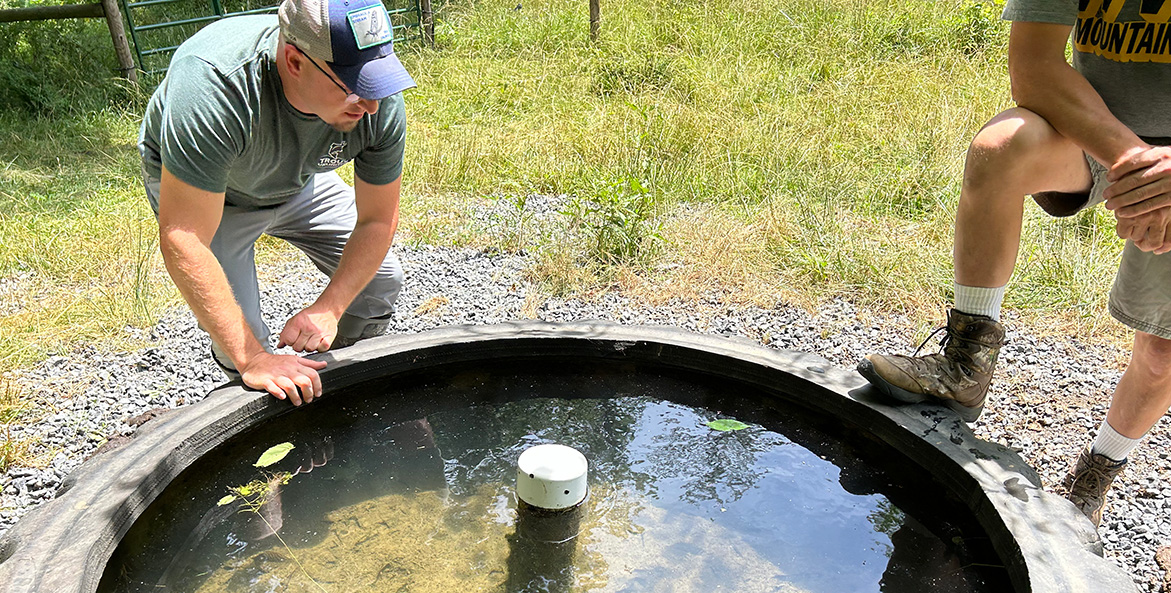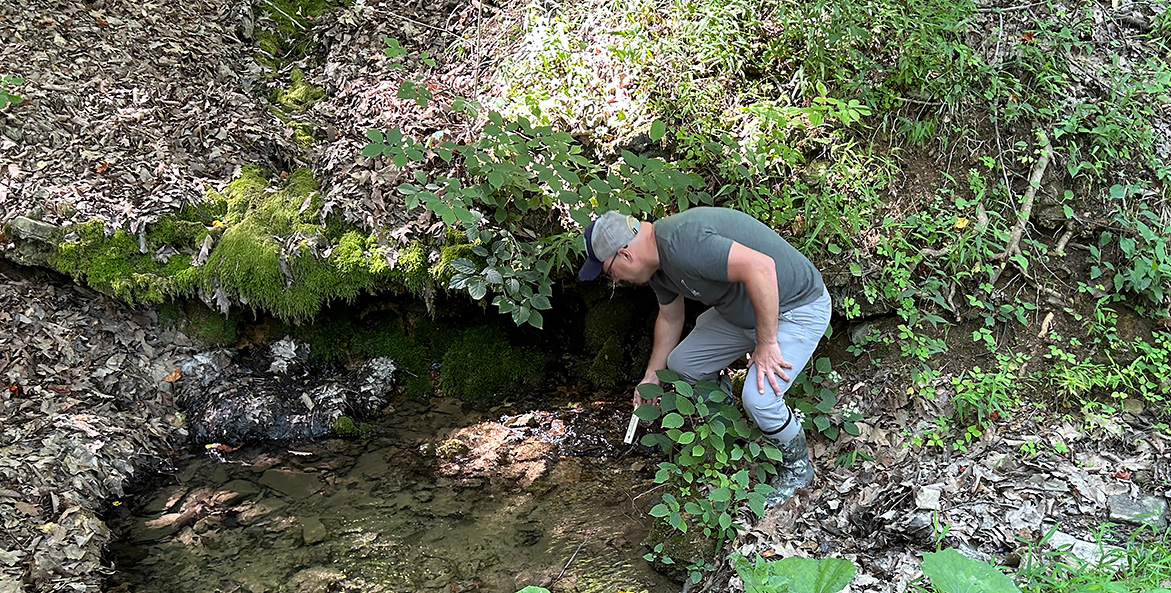This is the third blog in a series of stories about the great clean water work that is happening upriver in West Virginia, Delaware, and other states that don’t directly border the Bay. Much of the funding and resources for this critical work are only made possible through the landmark 40-year Bay partnership, a collaborative effort between states, the federal government, and local partners to reduce pollution and restore habitats across our remarkable watershed.
About eight years ago, Greg Hulver decided it was time to bring brook trout home to Reed Spring. A small tributary of the Lost River, Reed Spring runs through 100 acres of land in West Virginia’s Eastern Panhandle that has been in his family for generations.
He had fished for brook trout there back when it was his granddad’s farm and the fishing was good, Hulver recalls.
“As a kid, we could come here and trout fish. We’d catch six, eight trout no problem,” he said. “Over the years, the trout were depleted, and I was trying to figure out a way to restore the stream. I knew I couldn’t do it on my own.”
Hulver knew the conservation group Trout Unlimited (TU) had recently opened a new chapter nearby.
What he didn’t know was that Dustin Wichertman, then a project manager for Trout Unlimited, had drawn a circle on a map with “a big ol’ question mark,” as he tells it, in the same location as Hulver’s property, wondering if brook trout existed there.
Hulver called TU and left a message. Wichterman called him back a few minutes later, and a successful partnership was born. Wichterman is now associate director of TU’s Mid-Atlantic Coldwater Habitat Program.
“It’s like you were sent to me,” Wichterman said to Hulver on a sunny morning in late June, as they checked on native trees they’d planted near Reed Spring a few years ago.
Although hundreds of miles apart, Reed Spring and the Bay need the same thing—clean water.
Reed Spring starts on Hulver’s property. Pristine water spills out of a hillside, chilled to the perfect temperature for brook trout by the limestone beneath. But as the spring makes its way to the Lost River, excess nutrients from livestock waste and roadside ditches flowing polluted runoff into the spring were degrading water quality and making the water too warm for the sensitive species to thrive.
After getting “lost” underground for a stretch, the Lost River emerges as the Cacapon River. The Cacapon flows into the Potomac River, which empties into the Chesapeake Bay in Virginia Beach.
Although hundreds of miles apart, Reed Spring and the Bay need the same thing—clean water. That means restoring Potomac headwater streams like Reed Spring isn’t just good for West Virginia’s beloved state fish and people who love to fish for them. It also makes for better water quality downstream in the Potomac River and the Chesapeake Bay.
Why Are Brook Trout Important?
Brook trout are an important part of the Bay watershed ecosystem. Because they need cool, clean water to survive, they are an excellent indicator that a stream is healthy. That’s why increasing the native population is among the goals the six states in the region set for themselves in the 2014 Chesapeake Bay Watershed Agreement. Other goals include reducing water pollution, improving wildlife habitat, conserving land, and boosting climate resiliency.

Trout Unlimited's Dustin Wichterman (left) and farm owner Greg Hulver check on one of the water troughs created to provide drinking water for Hulver's cattle, which have been fenced out of Reed Spring, one of several conservation practices Hulver has invested in.
Lisa Caruso/CBF Staff
TU and Hulver are doing their part. The work they began in 2016 planting trees, fencing cattle out of the stream, shoring up eroded banks, removing barriers that kept brook trout from reaching the cool water upstream, and installing water troughs to give the animals another source of drinking water has yielded impressive results.
“We’ve seen a complete rebound in the trout population” within the first five years, Wichterman said.
When TU first started sampling the population, he continued “we’d see brook trout numbers around eight, six, seven fish. Now we get 75 fish and reach within three different age classes of fish and [see] fish that are up to 12 inches. That’s pretty big for brook trout.”
The native plants and trees installed near Reed Spring are bringing pollinators back, too, Wichterman said. Stoneflies, caddisflies, and mayflies—three insects that live on the stream bottom and provide food for trout, are back, another signal that water quality is good, TU Project Manager Ryan Cooper explained.
Support from Many Areas is Critical for Success
TU and Hulver drew funding from many sources. Agriculture Department conservation programs helped pay for forested buffers to protect the stream from livestock, troughs to ensure they have drinking water, safe paths to cross the stream, and native materials like rocks and trees to restore stream banks and in-stream trout habitat.
But those programs don’t cover everything. A landowner like Hulver might still have to contribute thousands of dollars out of his pocket for a project this complicated, Wichterman said. To bridge the gap, TU uses Chesapeake Bay Program grant money to defray some of the landowner’s costs. In return, the landowner donates their labor and materials for the job.
Finally, they secured a perpetual conservation easement so Hulver can pass the property on to his son and protect it from development well into the future.
“Greg and his family wanted to do the right thing for their land, which was to try to conserve it for future generations just like it had been passed down to them,” Wichterman said. “Not only did we restore the stream, but we protected it into the long term.”
Helped in part by Chesapeake Bay Program grants, their work is also helping to protect Lost River, the Cacapon River, the Potomac River, and the Bay itself.

Washington, D.C. Communications & Media Relations Manager, CBF
[email protected]
202-793-4485



